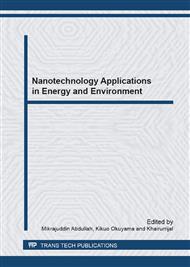[1]
F. P. La Mantia, M. Morreale, Green composites, a Brief Review, Composites Part A 42 (2011) 579-588.
DOI: 10.1016/j.compositesa.2011.01.017
Google Scholar
[2]
A.E. Goulas, K. I. Anifantaki, D.G. Kolioulis, Migration of Di-(2-ethylhexyl) Adipate Plasticizer from Food-Grade Polyvinyl Chloride Film into Hard and Soft Cheeses, J. Dairy Sci. 83 (2000) 1712–1718.
DOI: 10.3168/jds.s0022-0302(00)75040-5
Google Scholar
[3]
Favier,V., Chanzy,H., and Cavaille J.Y. Polymer Nanocomposites Reinforced by Cellulose Whiskers, Macromolec. 28 (1996) 6365-6367.
DOI: 10.1021/ma00122a053
Google Scholar
[4]
L. Chazeau, J. Y. Cavaillé, P. Terech, Mechanical Behaviour above Tg of a Plasticized PVC Reinforced with Cellulose Whiskers: a SANS Structural Study, Polymer 40 (1999) 5333-5344.
DOI: 10.1016/s0032-3861(98)00748-4
Google Scholar
[5]
Y. Soudais, L. Moga, J. Blazek, F. Lemort, Coupled DTA-TGA-FTIR Investigation of pyrolytic decomposition of EVA, PVC and cellulose, J. Anal. Appl. Pyrolysis 78 (2007) 46-57.
DOI: 10.1016/j.jaap.2006.04.005
Google Scholar
[6]
D.R. Mulinari, H.J.C. Voorwald, M.O.H. Cioffi, M.L.C.P. Da Silva, T.G. da Cruz, C. Saron, Sugarcane Bagasse Cellulose/ HDPE Composites Obtained by Extrusion, Composites Sci. Tech. 69 (2009) 214-219.
DOI: 10.1016/j.compscitech.2008.10.006
Google Scholar
[7]
C. Alves, P.M.C. Ferrão, A.J. Silva, L.G. Reis, M. Freitas, L.B. Rodrigues, D.E. Alves, Ecodesign of Automotive Components Making Use of Natural Jute Fiber Composites, J. Cleaner Prod. 18 (2010) 313-327.
DOI: 10.1016/j.jclepro.2009.10.022
Google Scholar
[8]
A. Ashori, Wood–plastic Composites as Promising Green-composites for Automotive Industries, Biores. Technol. 99 (2008) 4661-4667.
DOI: 10.1016/j.biortech.2007.09.043
Google Scholar
[9]
H. Ku, H. Wang, N. Pattarachaiyakoop, M. Trada, A review on the Tensile Properties of Natural Fiber Reinforced Polymer Composites, Composites Part B: Eng. 42 (2011) 856-873.
DOI: 10.1016/j.compositesb.2011.01.010
Google Scholar
[10]
L. Avérous, C. Fringant, L. Moro. Plasticized Starch-Cellulose Interaction in Polysaccharide Composites. Polym. 42 (2001) 6565-6572.
DOI: 10.1016/s0032-3861(01)00125-2
Google Scholar
[11]
H.A. Pushpadass, P. Bhandari, M.A. Hanna. Effect of LDPE and Glycerol Content and Compounding on The Microstructure and Properties Of Starch Composite Film. Carbohydrate Polym. 82 (2010) 1082-1089.
DOI: 10.1016/j.carbpol.2010.06.032
Google Scholar
[12]
I. Arvanitoyannis, C.G. Biliaderis, H. Ogawa, N. Kawasaki. Biodegradable Films Made From Low-Density Polyethylene (LDPE), Rice Starch and Potato Starch For Food Packaging Applications: Part 1. Carbohydrate Polym. 36 (1998) 89-104.
DOI: 10.1016/s0144-8617(98)00016-2
Google Scholar
[13]
I.M. Thakore, S. Desai, B.D. Sarawede, S. Devi. Studies on Biodegradability, Morphology and Thermo-Mechanical Properties of LDPE/modified Starch Blends. Eur. Polym. J. 37 (2001) 151-160.
DOI: 10.1016/s0014-3057(00)00086-0
Google Scholar
[14]
R.R.N. Sailaja, M.V. Deepthi. Mechanical and Thermal Properties of Compatibilized Composites of Polyethylene and Esterified Lignin. Material and Design 31 (2010) 4369-4379.
DOI: 10.1016/j.matdes.2010.03.046
Google Scholar
[15]
H. Wang, R. Chang, K. Sheng, M. Adl, X. Qian. Impact Response of Bamboo with The Properties of Bamboo and Polyvinylchloride (PVC). J. Bionic Eng. Suppl. 2 (2008) 28-33.
DOI: 10.1016/s1672-6529(08)60068-2
Google Scholar
[16]
Y.T. Zheng, D.R. Chao, D.S. Wang. J.J. Chen. Study On The Interface Modification of Bagasse Fibre and The Mechanical Properties of Its Composite With PVC. Composite Part A 38 (2007) 20-25.
DOI: 10.1016/j.compositesa.2006.01.023
Google Scholar
[17]
I. Bonadies, M. Avella, R. Avolio, C. Carfagna, G. Gentile, B. Immirzi, M.E. Errico. Probing The Effect Of High Energy Ball Milling on PVC Through a Multitechnique Approach. Polym. Testing 31 (2012) 176-181.
DOI: 10.1016/j.polymertesting.2011.10.010
Google Scholar
[18]
H. Wiebking, Filler in PVC: a Review of The Basic, Specialty Minerals Inc. (1998).
Google Scholar
[19]
A. Sionkowska, Current research on the blends of natural and synthetic polymers as new biomaterials: Review, Prog. in Polym. Sci. 36 (2011) 1254-1276.
DOI: 10.1016/j.progpolymsci.2011.05.003
Google Scholar
[20]
S.M. Luz, A.R. Goncalves, A.P. Del'Arco Jr . Mechanical Behaviour and Microstructural Analysis of Sugarcane Bagasse Fiber reinforce Polypropylene Composite. Composites A 38 (2007) 1455-1461.
Google Scholar
[21]
P. Ganguly, W.J. Poole. Characterization of Reinforcement Distribution Inhomogeneity in Metal Matrix Composites. Mater Sci Eng A 332 (2002) 301-310.
DOI: 10.1016/s0921-5093(01)01757-9
Google Scholar
[22]
M. A. Da Silva, M. G. A. Vieira, A. C. G. Mocumoto, M. M. Beppu, Polyvinylchloride (PVC) and natural rubber films plasticized with a natural polymeric plasticizer obtained through polyesterification of rice fatty acid, Polym. Testing 30 (2011) 478-484.
DOI: 10.1016/j.polymertesting.2011.03.008
Google Scholar
[23]
A. Ramesh, K. H. Leen, K. Kumutha, A. K. Arof, FTIR studies of PVC/PMMA blend based polymer electrolytes, Spectrochim. Acta Part A 66 (2007) 1237.
DOI: 10.1016/j.saa.2006.06.012
Google Scholar
[24]
D. Feldman, D. Banu, Contribution to the study of rigid PVC polyblends with different lignins, J. Applied Polym. Sci. 66 (1997) 1731-1744.
DOI: 10.1002/(sici)1097-4628(19971128)66:9<1731::aid-app11>3.0.co;2-y
Google Scholar
[25]
Q. Yao, C.A. Wilkie. Thermal Degradation of PVC in the Presence of Polystyrene. J. Vinyl Addit Technol. 7 (2001) 26.
DOI: 10.1002/vnl.10261
Google Scholar
[26]
M.C. Sunny, P. Ramesh, K.E. George, Use of polymeric plasticizer in polyninyl chloride to reduce conventional plasticizer migration for critical applications, J. Elastom Plast. 36 (2004) 19
DOI: 10.1177/0095244304038016
Google Scholar


